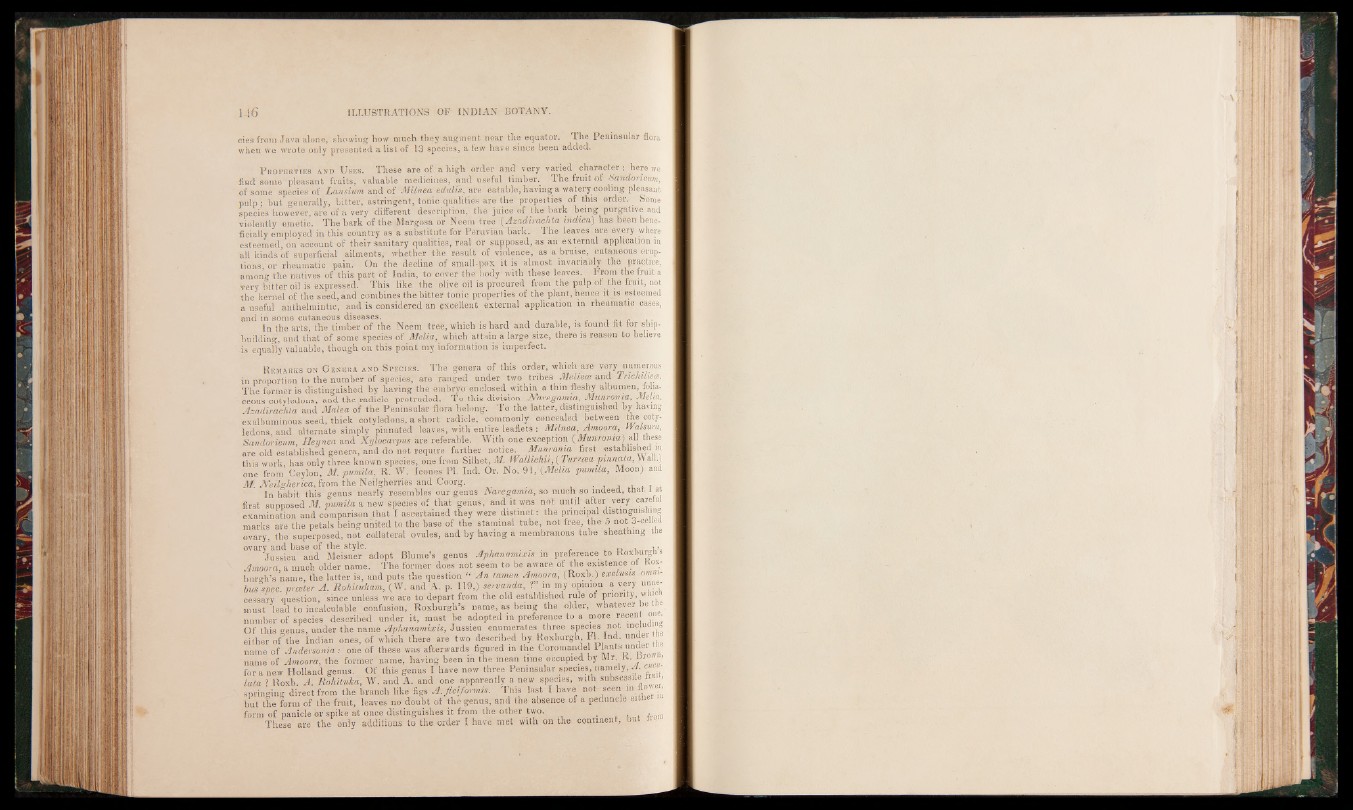
cies from Java alone, showing how much they augment near the equator. The Peninsular flora
when we wrote only presented a list of 13 species, a few have since been added.
P roperties and Uses. These are of a high order and very varied character : here we
find some pleasant fruits, valuable medicines, and useful timber. The.fruit of Sandoricum,
of some species of Lansium and of Milnea edulis, are eatable, having a watery cooling pleasant
pulp; but generally, bitter, astringent, tonic qualities are the propeities of this order. Some
species however, are of a very different description, the juice of the'bark being purgative and
violently emetic. The bark of the Margosa or Neem tree (Azadirachta indien) has been beneficially
employed in this country as a-substitute for Peruvian bark. ’The leaves are every where
esteemed, on account of their sanitary qualities, real or supposed, as an external application in
all kinds of superficial ailments; whether the result of violence, as a bruise, cutaneous eruptions,
or rheumatic pain. On the decline of small-pox it is almost invariably the practice,
among the natives of this part of India, to cover the body with these leaves. From the fruit a
very bitter oil is expressed. This like the olive oil is procured from the pulp of the fruit, not
the kernel of the seed, and combinés the bitter tonic properties of the plant, hence it is esteemed
a useful anthelmintic, and is considered an excellent external application in rheumatic cases,
and in some cutaneous diseases. _ [ . - , „ -■ ,.
In the arts, the timber of the Neem tree, which is hard and durable, is found tit tor snipbuilding,
and that of some species of Melin, which attain a large size, there is reason to believe
is equally valuable, though on this point my information is imperfect.
R emarks on G enera and Species. The genera of this order, which are very numerous
in proportion to the number of species, are ranged under two tribes Jl/eZ/eoe and Trichilieoe.
The former is distinguished by having the embryo-enclosed within a thin fleshy albumen, folia,
ceous cotyledons, and the ^radicle protruded. To this division .Afaregamia, Mimroiim, Melta,
Azadirachta and Malea of the Peninsular flora belong. To the latter, distinguished by having
exalbuminous seed, thick cotyledons, a short radicle, commonly concealed between the cotyledons,
and alternate simply pinnated leaves, wittrentire leaflets : Milnea, Amoora, fValsuru,
Sandoricum, Heynea and Sylocarpus are referable. With one exception (Munroiua) all these
are old established genera, and do not require further notice. Munronm first established m
this work has only three known species, one from Siihet, M. IValiichii, ( Turrcea pmnata, yvall.)
one from" Ceylon, M. pumila, R. W. leones PI. Ind. Or. No. 91,'(A?etta pumita, Moon) and
M: JVeilgherica, from the Neilgherries and Coorg. . - , T
In habit this genus nearly resembles our genus Naregamia, so much so indeed, that 1 at
first supposed M. pumila a new' species of that genus, and it was not untiT after very careful
examination and comparison,that I ascertained they were distinct: the principal distinguishing
marks are the petals being united to the base of the staminal tube, not free, the 5 not 3-celleU
ovary, the superposed, not collateral ovules, and by having a membranous tube sheathing tile
ovary and base of the style. ‘ • . . . „ , )
Jussieu and Meisner adopt Blume’s genus Aphanamixis in preference^ Koxburgn
Amoora, a much older name. The former does not seem to be aware of the existence ot Kox-
burgh’s name the latter is, and puts the question “ An tamen Amoora, (Roxb.) exclusifs .omnibus
spec. prater A. Rokitukam, (W. and A. p. 119,) servanda, V’ in my opinion a very unne-
: unless we are to depart from the old established rule of priority, win
, ot which there are two aescrioeci oy n . u x u u i S u , j. y - y — - - - ,
name of Andersonia : one of these was afterwards figured in the C o im a i d e l P k t s uiidei i
name of Amoora, the former name, having been in the mean time occupied by Mr, K. ero >
for a new Holland genus. Of this genus I have now three Peninsular species, namely, A, c
lata i Roxb A. Rohituka, W. and A. and one apparently a new species, with subsessile ir ,
springing direct from the branch like figs A.fidformis. This last I have notr seen m flo«^
but the form of the fruit, leaves no doubt of the genus, and the absence of a peduncle either
form of panicle or spike at once distinguishes it from the other two. I
These are the only additions to the order I have met with on the continent, but ir